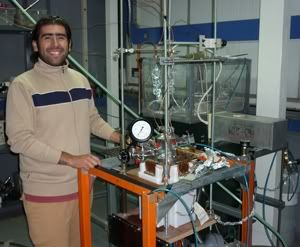| |
2011-03-12
His Ph. D. thesis was qualified as outsanding
Dr. Ariel Tarifeño, as student of the Ph.D. Program from Universidad de Concepción, started working at the laboratory of the Thermonuclear Plasma Department of the Chilean Nuclear Energy Commission (DPTN-CCHEN) in 2006, in the framework of the realization of his thesis work under the supervision of Dr. Leopoldo Soto.
 The examining committee from Universidad de Concepción was composed by Dr. Felix Bototto from Universidad de Concepción, Prof. Mario Favre from Pontificia Universidad Católica de Chile and Prof. Leopoldo Soto from P4-DPTN-CCHEN. This committee unanimously qualified as outstanding Dr. Tarifeño’s work. Thus, he received the maximum score (100 points). This makes DPTN be proud of this achievement and reinforces the objectives of the department regarding the formation of highly qualified human resources. The examining committee from Universidad de Concepción was composed by Dr. Felix Bototto from Universidad de Concepción, Prof. Mario Favre from Pontificia Universidad Católica de Chile and Prof. Leopoldo Soto from P4-DPTN-CCHEN. This committee unanimously qualified as outstanding Dr. Tarifeño’s work. Thus, he received the maximum score (100 points). This makes DPTN be proud of this achievement and reinforces the objectives of the department regarding the formation of highly qualified human resources.
Dr. Tarifeño´s thesis is entitled “Experimental Study of a Tens of Joules Small Fast Plasma Focus Discharge Emitting Neutrons”. This work deals with the “characterization and optimization for neutron emission of a plasma focus device that operates at tens of joules”. This equipment is a table-top device (portable) which magnetically confines a plasma at very high densities (compared to the outer core of the sun), and it produces neutrons when it is operated with Deuterium by nuclear fusion reactions. One of the interesting results of this work it is the development of a methodology for measuring pulsed fast neutrons with high resolution in real time. This methodology is suitable for the development of real time dosimeters for pulsed neutrons.
“The realization of my Ph.D. thesis and its evaluation is the best sign of the huge contribution that CCHEN and P4 give to the formation of high qualified human resources, particularly in scientific-technological areas where it is not possible to find the appropriate facilities or competences in other places of the country.”- Dr. Tarifeño commented in relation to the formation of highly qualified people in these areas. Dr. tarifeño’s research was supported by the Project Anillo from the Programa Bicentenario o CONICYT (today called Programa de Investigación Asociativa de CONICYT). |
|
 |
|
|
|
| |
|
|

